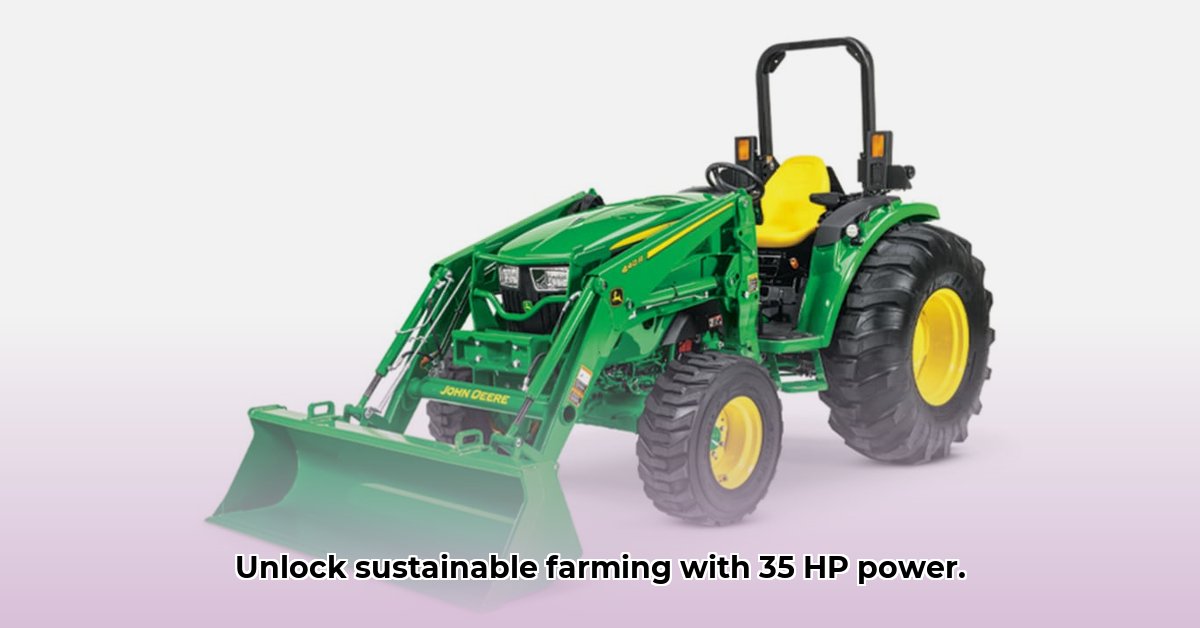
Technical Specifications and Features of the John Deere 3038E
The John Deere 3038E, a 35 horsepower tractor, is frequently positioned as a sustainable solution for smaller-scale agricultural operations. This detailed review analyzes its technical specifications, performance, cost, and market viability within the context of sustainable farming practices. Does this tractor deliver on its promise of efficiency and environmental responsibility? Let's explore. For more information on larger John Deere tractors, check out the John Deere 5000 Series.
The 3038E's core is a Yanmar diesel engine, generating approximately 34.5 horsepower. This engine utilizes a common rail system (CRS) (a fuel injection system delivering precise fuel amounts to each cylinder for optimal combustion) for enhanced fuel efficiency and reduced emissions. Further minimizing environmental impact are the integrated diesel particulate filter (DPF) and diesel oxidation catalyst (DOC), which help to remove pollutants from the exhaust. This translates to lower running costs and a smaller carbon footprint—critical elements for sustainable agriculture. But how does this performance translate to the field?
| Feature | Details |
|---|---|
| Engine | Yanmar, approximately 34.5 horsepower, common rail system (CRS) |
| Transmission | Hydrostatic Transmission (HST) – providing smooth and precise control |
| Safety Features | Roll-over protective structure (ROPS), automatic engine shutoff (with PTO engaged or in gear) |
| Hydraulic System | Integrated pump and motor system (Sauer-Danfoss) for reliable hydraulic power |
| Operator Conveniences | Twin Touch™ foot pedals, optional cruise control, adjustable seat |
Isn't the ease of operation, combined with the robust safety features, crucial for maximizing productivity and minimizing operator fatigue? The Twin Touch foot pedals, for example, allow for precise control, while the automatic engine shutoff enhances safety.
Performance Analysis: Fuel Efficiency, Emissions, and Operational Capabilities
A key selling point of the 3038E is its fuel efficiency. The combination of the CRS technology and the automatic DPF regeneration contributes to reduced fuel consumption and minimizes downtime associated with manual cleaning. However, to fully assess its performance, independent testing and real-world user data are necessary for a complete comparative analysis against competitors' models. Initial reports suggest promising fuel economy; however, comprehensive data are still needed to definitively quantify this advantage.
How does the 3038E's emissions profile compare to similar tractors? While the DPF and DOC significantly reduce particulate matter and other pollutants, a thorough emissions analysis is required for a truly comprehensive comparison. Considering the growing importance of reducing greenhouse gas emissions in agriculture, this aspect is critical for evaluating the tractor's suitability for sustainable operations. Where can we find this crucial performance data?
Cost Analysis: Total Cost of Ownership (TCO)
While the initial purchase price of the John Deere 3038E might be higher than some competitors, the total cost of ownership (TCO) requires a detailed examination across several factors. Specialized servicing for the sophisticated engine and transmission might increase maintenance costs. Thus, a long-term cost analysis is essential.
Does the increased fuel efficiency and reduced downtime outweigh the higher initial purchase price and potential maintenance expense? This depends on various factors, including anticipated annual operating hours, access to service facilities, and the specific tasks the tractor will perform. A farmer considering this tractor must conduct their own detailed cost analysis using data specific to their operations. Remember that fuel costs, insurance, taxes, and labor all contribute to the overall TCO.
Market Assessment: Target Market, Challenges, and Viability
The John Deere 3038E is primarily targeted toward small-scale farmers and landowners. This aligns with the growing interest in sustainable agriculture practices. However, challenges persist. The initial purchase price could be prohibitive for some smaller operations. Furthermore, access to specialized service and parts, particularly in rural areas, remains a critical factor determining the tractor's overall viability. The availability of government subsidies and financial assistance programs can fundamentally influence market penetration and affordability for many potential buyers.
What role do factors like ease of financing, training programs for operators, and readily available support networks play in the market success of the John Deere 3038E?
Conclusion: Suitability for Small-Scale Sustainable Agriculture
The John Deere 3038E presents a compelling case for small-scale sustainable farming, particularly concerning its fuel efficiency and lower emissions. However, a thorough cost-benefit analysis is crucial for potential buyers. Accessibility to service, the specific farming operations, and individual financial situations significantly influence the suitability of this tractor. The availability of more comprehensive data on fuel efficiency, emissions, and long-term maintenance costs would greatly enhance the assessment of its overall viability for sustainable agricultural practices. Additional user feedback and comparative analysis with competing models are needed for a more definitive conclusion.